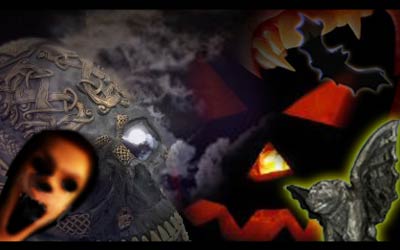Top 5 Halloween Myths Debunked

The annual Halloween ritual of candy, scary home-made costumes and trick-or-treating hearkens back to childhood innocence.
But while it's all harmless fun, Halloween is also a playground for myths and urban legends ranging from simple false beliefs to serious issues around children's safety. There are also some odd economic realities behind the curtains that are relevant during the nation's current financial crisis.
So in the darkness of this strange holiday, here are five things you should know:
1. Pure logic concludes that real-life vampires are impossible.
The percentage of Americans who believe in present-day vampires is at a dangerously high level, says University of Central Florida physicist Costas Efthimiou, who debunks pseudoscientific ideas in attempts to enhance public literacy.
Here is the outline of the belief: Legend has it that vampires feed on human blood, and once bitten, the victim also becomes a vampire and starts feasting on the blood of others. This supposedly accounts for an exponential increase of these widely feared creatures.
Efthimiou's debunking logic goes like this: On Jan. 1, 1600, the human population was 536,870,911. If the first vampire came into existence that day and bit one person a month, there would have been two vampires by Feb. 1, 1600. A month later there would have been four, and so on. In just two-and-a-half years the original human population would all have become vampires with nobody left to feed on, even if our entire species doubled each month.
Get the world’s most fascinating discoveries delivered straight to your inbox.
So whatever you think you see prowling around on Oct. 31, it most certainly won't turn you into a vampire and we won't be living in a real-life, B-rated zombie movie anytime soon.
2. Consuming Almond Joys and other Halloween chocolates does not ward off cancer.
Avoid any wildly simplistic rumors of chocolate sweets aiding in the prevention of cancer this Halloween season. Turns out that it's not the chocolate candy per se that has anticancer properties: The Lombardi Comprehensive Cancer Center at Georgetown University finds that it's an ingredient in cocoa, from which chocolate is made, called pentameric procyanidin.
Research at the University of California, Davis, contributes to more delicious findings, that epicatechin, one of a group of chemicals present in cocoa known as flavanols, is directly linked to improved circulation by the relaxing of vascular tissues, and other hallmarks of cardiovascular health in humans.
These studies provide evidence that there are health benefits observed after the consumption of certain flavanol-rich cocoas, but it is still not recommended to inhale Milky Ways in attempts to lower blood pressure or fight cancer.
3. You have a better chance of being hit by a car on a dark street than finding secret razor blades in candies.
Police and medical centers across the country annually take precautions to prevent candy tampering during the Halloween season. Each year, X-ray equipment is overloaded to check Halloween items for harmful objects, such as razors, needles or other objects that might have been placed there to hurt or kill children.
However, few if any threatening foreign objects are found, with the "unfortunate victim" sometimes revealed as the culprit, in search of media attention. Essentially, these precautions are wasting resources and fueling an urban legend, as well as children's fears.
There have been only two confirmed cases of children being killed by poisoned Halloween candy, and in both cases the children were killed intentionally by one of their parents. The best known, "original" case was that of Texan Ronald Clark O'Bryan, who killed his son by lacing his Pixie Stix with cyanide in 1974.
With the exceptions noted above, no child has been killed or seriously harmed by contaminated Halloween candy.
4. Halloween won't save America's consumer crisis.
Many people are under the impression that Halloween is the second-busiest retail holiday of year, beaten only by Christmas. In fact, The National Retail Foundation ranks it sixth overall, behind Father's Day, Easter, Valentine's Day, Mother's Day and the winter holidays. So, as for the pumpkin-happy holiday offsetting the Dow Jones from its financial debacle, don't count on it.
October is usually considered a vigorous month for heavy spending — between Halloween shopping and cooling weather driving consumers to search for winter gear — but it's shaping up to be a nationwide letdown, according to The Wall Street Journal. Consumers have clung so far to their newly modest spending habits. What's more, this year's Fright Night comes on the heels of a back-to-school shopping season that was considered mostly a bust, the newspaper reported.
5. There has not been a single case of any child being molested by a convicted sex offender while trick-or-treating.
Foremost, it is fairly implausible that a criminal could molest an elaborately dressed child in costume, outside the front door, in front of numerous witnesses and parents.
The "stranger danger" concern is a relatively recent phenomenon, and the emergence of sex offender laws across the country have resulted in thousands of convicted sex offenders abiding by a strict curfew and not answering their doors to trick-or-treaters on the night of Halloween. However, Georgia, New Jersey and Indiana have recently overturned sex offender laws found to be unduly restrictive, according to JURIST, a Web-based legal news and real-time legal research service.
The fact is there is no evidence that indicates these laws actually make children any safer. In 2007, Human Rights Watch concluded in a report that it is unclear whether sex offender laws "do more harm than good," noting that they might encourage harassment and ostracism of sex offenders who have served their time. In addition, most released sex offenders do not re-offend, contrary to popular belief, and most attacks on children occur in their own home by someone they know.
There is no doubt these special considerations are well-intentioned, but there is no reason to think that sex offenders pose any more of a threat to children on Halloween than at any other time.


